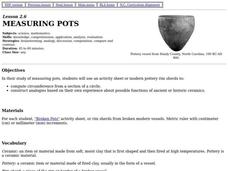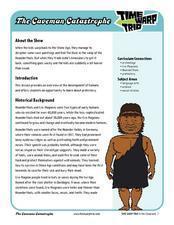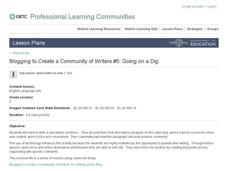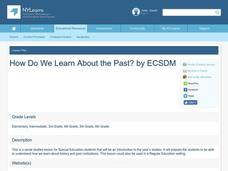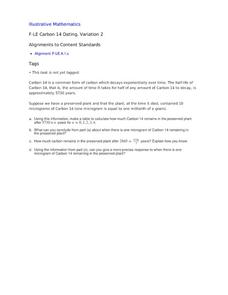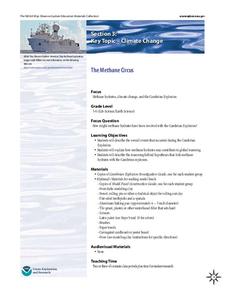Curated OER
Stone Tool Scavenger Hunt
Seventh graders use Internet to familiarize themselves with variety of stone tools used by early man, create information chart describing each tool and its purpose, and discuss why tools have survived thousands of years.
Curated OER
We, the First People
Young scholars explore new support regarding the earliest peopling of America by examining multiple theories on the migration of the first people to America, investigating related archaeological finds, and creating research-based...
Curated OER
Measuring Pots
Students use an activity sheet to construct analogies about possible function of ancient or historic ceramics and compute circumference from a section of a circle as they study measuring pots.
Curated OER
Ancient Civilizations
Sixth graders, in groups, research the culture of an ancient civilization. They use the Internet to locate artifacts that illustrate different elements of culture, write a description and analysis of each piece and present their work to...
Curated OER
Can You Dig It?
Students use a mock archaeological site to dig up artifacts. They read an article about artifacts found in Syria. They develop a list of artifacts that are related to specific sites in the community. They create an exhibition of these...
Odyssey of the Mind
Odyssey of the Mind Curriculum Activity: Digging for Clues
Make critical and creative thinkers out of your class, with an archeology-based project they'll love. They start the activity by first researching what archeologists do, then they generate a list of the qualities archeologists need to be...
Curated OER
Mapping the Aegean Seafloor
Earth science learners create a two-dimensional topographic map of the floor of the Aegean Sea. They use it to then create a three-dimensional model of the ocean floor features. This comprehensive resource delivers strong background...
Curated OER
Cyberspace Safari
Middle schoolers go on an information gathering hunt on the Internet to study West African empires. They work in teams; meteorologists, bankers, writers, and archaeologists. They collect data on all sorts of topics related to West...
Time Warp Trio
The Caveman Catastrophe
Young archaeologists study the development of human history, and work in groups to create a timeline that traces the development of humans. Additionally, the groups utilize a very clever graphic organizer embedded in the plan in order to...
Curated OER
Lesson: Snake Handling
Are the studies of art and archeology connected? You bet they are! Young scholars research the ancient temples of Mexico by visiting an archaeology site. They describe the various temples they see, taking note of shapes, stairs, details,...
Curated OER
Blogging To Create A Community of Writers # 5 of 7
Here is instructional activity 5 from a 7 instructional activity unit on using blogging to create a community of writers. The aim of this instructional activity is to get students writing about what Archaeologists do and how they use...
Curated OER
Carbon 14 Dating
Evaluating and analyzing exponential functions will help your archaeologists find the amount of Carbon 14 remaining in a plant in this real-life task centered on carbon dating. Learners will also be introduced to the concept of half-life.
Curated OER
How Do We Learn About the Past?
Students examine archaeological discoveries. For this learning about the past lesson, students view a "Magic School Bus" video, discuss the role of an archeologist, and complete a graphic organizer. Students discuss a variety of...
Curated OER
Carbon 14 Dating, Variation 2
Your archaeologists begin this task with a table of values to estimate the time passed based on the half-life of Carbon 14 remaining in a plant. They then move on to find when a specific amount of Carbon 14 is present in the same plant,...
Global Oneness Project
After the Quake: Preserving the Artifacts of Kathmandu
On April 28, 2015, a 7.8 earthquake ruptured the Kathmandu Valley in Nepal. Seven UNESCO World Heritage sites are located in this valley. The efforts of experts and archeologists to restore three of them—Kathmandu Durbar Square, Patan...
NOAA
The Methane Circus
Step right up! An engaging research-centered lesson, the third in a series of six, has young archaeologists study the amazing animals of the Cambrian explosion. Working in groups, they profile a breathtaking and odd creature and learn...
Channel Islands Film
Cache: Lesson Plan 1 - Grades 9-12
Archaeologists have discovered a cache of Native American relics. They want to preserve these relics by removing them from the rapidly eroding site to a lab where they can be studied. Native American traditions demand that the items be...
Channel Islands Film
Once Upon a Time (Saxipak’a): Lesson Plan 4
How did the environment and natural resources found on the Channel islands influence the culture of the Chumash? Archaeology meets technology in an activity designed for middle schoolers. After viewing West of The West's documentary Once...
EngageNY
Evaluating Research
Calling all archaeologists! Scholars dig through their research about overfishing, searching for the best information to include in their consumer guides. Next, pupils engage in a pair-share activity to discuss their findings with a...
Museum of the American Revolution
Historical Analysis: Objects Tell Stories
Dig this! Young archeologists discover what objects teach us about the past. The activity uses an image of a Revolutionary War artifact to help historians practice analyzing the past. Scholars study the object and complete a worksheet to...
Museum of the American Revolution
Object Observation: Purpose on a Powder Horn?
Young archeologists discover the significance of ordinary objects from the past in an interesting lesson on artifact analysis. The activity focuses on examining the image of a powder horn from the Revolutionary War to understand what it...
K20 LEARN
The Spiro Mounds Builders: Oklahoma History
Long before European settlers arrived on the shores of what is now the United States, pre-contact Native American cultures thrived. Young scholars investigate the Spiro Mounds Builders' history and learn how archaeologists put together...
Curated OER
Transparent Shoebox Dig
Take this simulated archaeological dig one layer at a time with your young pupils to encourage observation, critical thinking, and careful attention. Using a transparent box full of layers of sand and artifacts, pupils examine the...
Curated OER
Sunken Slave Ship
Young scholars investigate shipwrecks. In this marine archaeology lesson, students create the site of a shipwreck by using a tub filled with sand and items from a "ship". Young scholars excavate the site and analyze the findings.
Other popular searches
- Archaeologist Tools
- Inference Archaeologist
- Think Like an Archaeologist
- Work of Archaeologist
- Tools of an Archaeologist
- Archaeologist Knossos
- Urban Archaeologist
- Archaeologist Booklet
- Analogies, Archaeologist
- Archaeologists Ireland
- Analogies Archaeologist
- Tools Archaeologists Use




